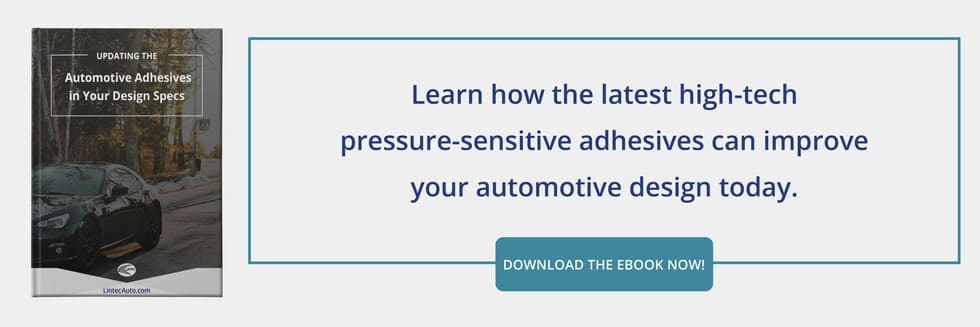Emblem adhesives may seem like a small concern in the complexity of the automotive assembly line, but anything that speeds up cycle times and improves component performance will add value. Older liquid and mechanical solutions (like glues, clips, or screws) get the job done, but they’re now overshadowed by the pure efficiency and reliability of automotive pressure sensitive adhesives (PSAs).
Here are six ways a PSA emblem adhesive will solve for design challenges and improve your assembly process.
Simple, Mess-Free Application
This may be one of the biggest advantages of PSAs over a liquid emblem adhesive. Unlike liquids, a PSA will not flow out from beneath the adhesive, require incredibly precise dispensing, or release harmful fumes into the work environment.
Instant Adhesion & Rapid Curing
PSAs accelerate cycle times over other emblem adhesive solutions because they adhere immediately and cure to 100% strength in short order. When die-cut to shape in advance, a PSA also means there’s minimal equipment or time required for application, compared to liquids or mechanical fasteners.
Lasts For the Life of the Vehicle
Modern emblem adhesives can easily outlast the car itself. There remains a misguided stigma that “tape” is a temporary adhesive, but double-sided automotive emblem PSAs can be trusted to endure beyond the useful life of the vehicle, even in harsh weather conditions and widely fluctuating temperatures.
Stable In Hot Sunlight
Intense heat can degrade, melt, and release adhesives that are not formulated for thermal resistance. Emblem adhesives in the vehicle interior are actually at even higher risk, due to the greenhouse effect from built-up sun heat on hot summer days. Adhesive layers should therefore be rated to remain stable at temperatures well over 157 degrees Fahrenheit (the average temperature of the dashboard in a car parked for one hour in sunny 95-degree weather).
High Torque and Shear Strength
Physical contact with the emblem is another threat. You’ll want an emblem adhesive that is designed not only to match the materials of the emblem and substrate, but specifically formulated to resist torquing and shearing forces. Today’s structural-strength emblem adhesives can withstand more than 1,000 psi in lap-shear tests (or even up to 4,000 psi) before failing, generally outlasting the emblem and the substrate themselves.
Immune to Vibration Damage
There are a few ways your emblem adhesive can solve for the stress of engine, road, and airflow vibrations—a common source of damage for many automotive components. Mechanical fasteners tend to fare poorly compared to adhesives, as the finite contact points and potential for loosening may lead to annoying rattles, squeaks, and movement in the emblem.
High-strength, thin-gauge, double-sided automotive PSAs form a perfectly rigid bond along the full contact surface of the emblem and help to reduce NVH. This will essentially fuse the emblem to the substrate and ensure that any vibrations pass through it evenly in phase with the underlying panel. Another option is an anti-vibration foam tape adhesive. A thin foam core absorbs the force of vibrations, ensuring that the emblem will never pull loose or rattle, among numerous other advantages.
If you’re looking for high-performance emblem adhesive solutions, our dynamic portfolio of film and foam PSAs will have options suited to your unique design needs and assembly specifications. Contact LINTEC Automotive and upgrade your assembly processes with reliable automotive adhesive products today.


